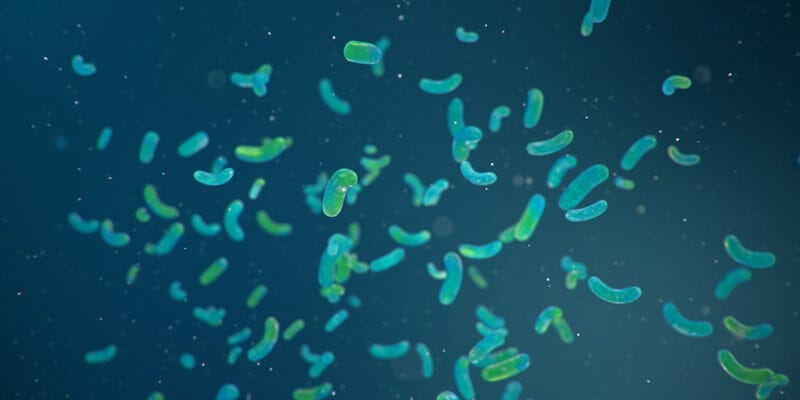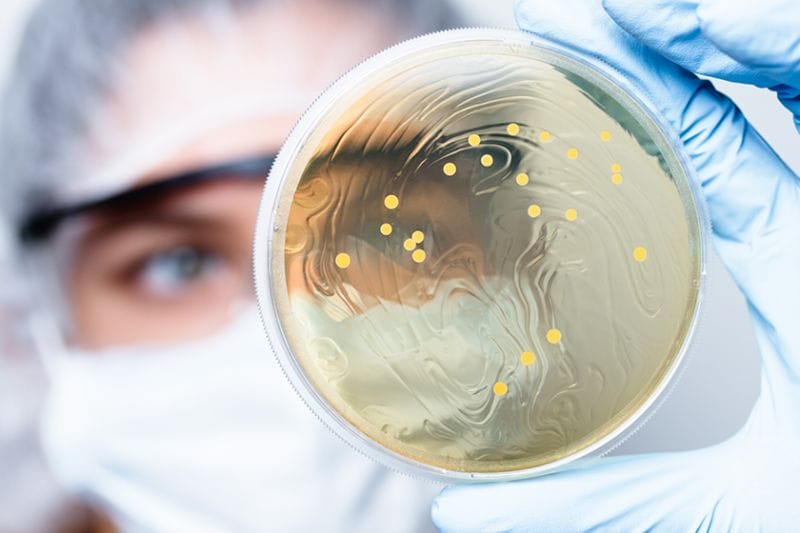Clostridium butyricum
Used for decades as a butyrate-producing probiotic, this beneficial bacterium is also linked to numerous immunological benefits related to GI-induced signalling that cascades to the liver, adipose tissue, brain, and more. present in the human gut: it is detected in 10–20% of the adult human population and is often one of the earliest colonisers in infants[1]
In the human gut, where it survives as a symbiont, Clostridium butyricum has a fermentative role that consumes undigested dietary fibres generating short-chain fatty acids (SCFAs), specifically butyrate and acetate. Butyrate is one of the dominant fermentation end-products and is produced via the butyrate kinase (buk) pathway[2]. SCFAs produced by microbial organisms in the colon are known to have myriad and important effects on host health, including modulating intestinal immune homeostasis, improving gastrointestinal barrier function, and alleviating inflammation. It is also suggested that Clostridium butyricum may modulate the composition of the gut microbiome, possibly increasing certain beneficial bacterial taxa such as Lactobacillus and Bifidobacterium[3].
Clostridium butyricum strengthens the gut barrier
The intestinal barrier performs a critical balancing act: maintaining the tolerance of gut microbiota and absorption of nutrients on the one hand, and defence against pathogen invasion on the other. It acts as a selective barrier, preventing the permeation of toxins and antigens while facilitating the absorption of nutrients, electrolytes, and water. Structurally, the intestinal barrier consists of three layers: the mucus layer, the epithelium, and the lamina propria[4]
Clostridium butyricum strains appear via mouse models to improve gut barrier function by increasing the thickness of the mucosal layer and increasing expression of tight junction (TJ) proteins. It is proposed that in part, the increased expression of TJ proteins may also result from Clostridium butyricum’s stimulation of IL-17 production from intraepithelial T cells. This improved barrier results in decreased permeation of lipopolysaccharides and pathogenic bacteria into the host tissue and blood[5]. Although often perceived as pro-inflammatory, IL-17 secreted locally by γδ T cells serves to protect and repair the gut barrier by ensuring expression of TJ proteins.
Clostridium butyricum has also been shown to promote the production of anti-inflammatory lipid metabolites such as palmitoleic acids, prostaglandin metabolites, and specialised pro-resolving mediators in mouse colonic tissues. Such lipid metabolites, especially protectin D1, contribute to the promotion of anti-inflammatory IL-10 secreting T-cells in the colon. This indicates that one of the other mechanisms of action in the colon affecting the modulation of host immunological and metabolic pathways is yet another protective mechanism of Clostridium butyricum in intestinal inflammation[6].
Clostridium butyricum promotes GI-induced Tregs
Tregs are a special group of effector T cells that oppose the inflammatory Th responses and therefore are anti-inflammatory. The Treg response restrains the inflammatory response by the production of IL-10, an anti-inflammatory cytokine that suppresses Th1, Th2, and Th17-mediated inflammation. Restoring the Treg response and maintaining a balance with pro-inflammatory responses may be a critical part of combatting inflammatory diseases.
Murine disease models have shown that administration of Clostridium butyricum promotes intestinal immune tolerance by increasing the abundance of Tregs, as evidenced by the accumulation of induced Tregs, especially in the mesenteric lymph node,[7] along with the decreased proportion of Th1 and Th17 cells in the disease target organs such as the pancreas, spleen, liver, brain, and intestines[8],[9].
Clostridium butyricum in the management of metabolic diseases
Metabolic diseases including diabetes (type 1 and type 2) and liver diseases are considered systemic conditions, as they arise from, and continue to affect, dysregulated inter-organ crosstalk. Even though Clostridium butyricum and other gut microbes are physically located in the gut lumen, their indirect effects extend from gut barrier integrity to immune modulation and endocrine regulation, consequently influencing metabolic signals throughout the body.
Clostridium butyricum as already described, increases the concentration of SCFA as well as the abundance of butyrate-producing bacteria in the gut. The associated increased secretion of Glucagon-like Peptide-1 (GLP-1) in the colon and the bloodstream can be attributed to the increased SCFA receptor signalling via GPR41 and GPR43[10]. GLP-1 has pleiotropic effects across many organs in reducing appetite, slowing gastrointestinal motility, decreasing gluconeogenesis and increasing glucose uptake, and most importantly, increasing the secretion of insulin from the pancreas[11].
Perraudeau & McMurdie et al. investigated Clostridium butyricum strain CBUT as part of a 5-strain and 3-strain consortium in a double-blind, placebo-controlled study of glycaemic control in subjects with type 2 diabetes[12]. Researchers concluded that the 5-strain consortium containing CBUT alongside strains of Akkermansia muciniphila, Anaerobutyricum hallii, Clostridium beijerinckii, and Bifidobacterium infantis caused a significant improvement in total glucose AUC0-180min relative to placebo following 12 weeks administration, as well as nominally-significant improvements in incremental glucose AUC0-180min and haemoglobin A1c.
Discussion
As summarised above, strains of Clostridium butyricum appear to enhance the gut’s ability to reduce microbial and immunological perturbations induced by antibiotics, pathogens, or other factors, making them interventions of potential importance in several health conditions. For humans, probiotic Clostridium butyricum strains are promising in the management of gastrointestinal symptoms, psychological conditions, and metabolic disease. Further work is required to elucidate clear dose and mechanism links, but this is one of the most exciting strains to enter clinical care and we can look forward to learning more as it becomes used in clinical work[13].
References
[1] Mountzouris KC, McCartney AL, Gibson GR. Intestinal microflora of human infants and current trends for its nutritional modulation. Br J Nutr. 2002 May;87(5):405-20.
[2] Guo P, Zhang K, Ma X, He P. Clostridium species as probiotics: potentials and challenges. J Anim Sci Biotechnol. 2020 Feb 20;11:24.
[3] an LL, Niu W, Fang X, Liang W, Li H, Chen W, Zhang H, Bhatia M, Sun J. Clostridium butyricum Strains Suppress Experimental Acute Pancreatitis by Maintaining Intestinal Homeostasis. Mol Nutr Food Res. 2019 Apr 29:e1801419.
[4] Ahmad R, Sorrell MF, Batra SK, Dhawan P, Singh AB. Gut permeability and mucosal inflammation: bad, good or context dependent. Mucosal Immunol. 2017 Mar;10(2):307-317. doi: 10.1038/mi.2016.128. Epub 2017 Jan 25..
[5] Pan LL, Niu W, Fang X, Liang W, Li H, Chen W, Zhang H, Bhatia M, Sun J. Clostridium butyricum Strains Suppress Experimental Acute Pancreatitis by Maintaining Intestinal Homeostasis. Mol Nutr Food Res. 2019 Apr 29:e1801419.
[6] Gobbetti T, Dalli J, Colas RA, Federici Canova D, Aursnes M, Bonnet D, Alric L, Vergnolle N, Deraison C, Hansen TV, Serhan CN, Perretti M. Protectin D1n-3 DPA and resolvin D5n-3 DPA are effectors of intestinal protection. Proc Natl Acad Sci U S A. 2017 Apr 11;114(15):3963-3968.
[7] Chen H, Ma X, Liu Y, Ma L, Chen Z, Lin X, Si L, Ma X, Chen X. Gut Microbiota Interventions With Clostridium butyricum and Norfloxacin Modulate Immune Response in Experimental Autoimmune Encephalomyelitis Mice. Front Immunol. 2019 Jul 23;10:1662.
[8] Jia L, Shan K, Pan LL, Feng N, Lv Z, Sun Y, Li J, Wu C, Zhang H, Chen W, Diana J, Sun J, Chen YQ. Clostridium butyricum CGMCC0313.1 Protects against Autoimmune Diabetes by Modulating Intestinal Immune Homeostasis and Inducing Pancreatic Regulatory T Cells. Front Immunol. 2017 Oct 19;8:1345.
[9] Zhang J, Su H, Li Q, Wu H, Liu M, Huang J, Zeng M, Zheng Y, Sun X. Oral administration of Clostridium butyricum CGMCC0313-1 inhibits β-lactoglobulin-induced intestinal anaphylaxis in a mouse model of food allergy. Gut Pathog. 2017 Feb 22;9:11.
[10] Ang Z and Ding JL (2016) GPR41 and GPR43 in Obesity and Inflammation – Protective or Causative? Front. Immunol. 7:28
[11] Drucker DJ. Mechanisms of Action and Therapeutic Application of Glucagon-like Peptide-1. Cell Metab. 2018 Apr 3;27(4):740-756.
[12] Perraudeau F, McMurdie P, Bullard J, Cheng A, Cutcliffe C, Deo A, Eid J, Gines J, Iyer M, Justice N, Loo WT, Nemchek M, Schicklberger M, Souza M, Stoneburner B, Tyagi S, Kolterman O. Improvements to postprandial glucose control in subjects with type 2 diabetes: a multicenter, double blind, randomized placebo-controlled trial of a novel probiotic formulation. BMJ Open Diabetes Res Care. 2020 Jul;8(1):e001319.
[13] Magdalena K. Stoeva, Jeewon Garcia-So, Nicholas Justice, Julia Myers, Surabhi Tyagi, Madeleine Nemchek, Paul J. McMurdie, Orville Kolterman & John Eid (2021) Butyrate-producing human gut symbiont, Clostridium butyricum, and its role in health and disease, Gut Microbes, 13:1



2 Comments. Leave new
Is the strain Clostridium butyricum present in any commercially available brands of probiotics yet?
Dear Eleanor the product contain this strain is https://nutrilink.co.uk/gi-repair-x-30caps